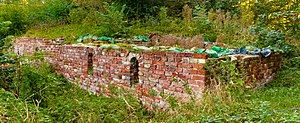Beningaburg (Grimersum)
| Beningaburg | ||
|---|---|---|
|
Remains of the Beningaburg in Grimersum |
||
| Alternative name (s): | Osterburg | |
| Creation time : | around 1426 | |
| Castle type : | Niederungsburg | |
| Conservation status: | Burgstall | |
| Standing position : | Gentry | |
| Place: | Grimersum | |
| Geographical location | 53 ° 28 '37.4 " N , 7 ° 10' 32.5" E | |
|
|
||
The Beningaburg is a lost moated castle . After the destruction of the ancestral seat, the little distant Beningaburg in Werdenum , the castle was the seat of the old East Frisian chief family Beninga , whose most prominent scion is the chronicler Eggerik Beninga . He was born in the castle and died there. In Grimersum there was another castle, the Westerburg , which is why the Beningaburg was also called Osterburg .
location
The marsh villages of Grimersum and Werdenum are located within a late medieval dike, on both sides of a sea bay that has silted up after being dammed . The Beningaburg is located at the east end of the village of Grimersum in the Aurich district in Lower Saxony .
Building description
The castle in Grimersum was a four-wing complex surrounded by a moat. The two-storey main building contained a knight's hall, a reading room and several living rooms. The main building was followed by low outbuildings that contained utility rooms.
history
The village gourd of Grimersum is of early medieval origin. In the 14th century it was extended to the east to include Burgplatz. First known resident Gerald Beninga, who lived in the complex in 1379 as chief in Grimersum and probably had it built himself. Hamburger and the Cirksena , allied with them, destroyed the castle, as well as the facility in Werdenum, in the dispute over supremacy in East Friesland, which took place in the early 15th century between the tom Brok and the Ukena and later the Cirksena and the Ukena with their respective partisans and allies played. The Beninga were allied with the defeated Ukenas at this time. A punitive expedition by the Hamburgers, allied with the Cirksena, to fight the piracy tolerated by the East Frisian chiefs finally sealed the end of the castle and the rule of the Beninga in 1435/36. The family remained wealthy, however, and had a new, contemporary castle built in Grimersum in 1450. This consisted of a four-wing complex that was surrounded by a moat .
Eggerik Beninga left the plant in 1548 at a Renaissance - castle rebuilt. He probably also laid the foundation stone for a library which, according to a catalog from the 18th century, is said to have comprised over 800 books. The plant began to decline in the 18th century. One of the two main wings, the so-called Westerburg, was abandoned at this time. In the 19th century the other main wing with the two side wings, the so-called Osterburg, fell into complete disrepair towards the end of the 19th century and collapsed in 1891. The area was then used as a quarry. The last parts of the building were demolished at the beginning of the 20th century. In 2002, as part of the village renovation, the castle complex was exposed and partially made accessible. The plan was to make the stumps of the walls of the building, the former ten-meter-wide trenches of the square as well as the bridge and gardens visible again. In 2016, the municipality of Krummhörn and the East Frisian landscape decided to only leave part of the already restored castle walls visible. The remaining walls are to be filled. The old moat could also be rebuilt. There is no funding for the further investigation of the facility.
See also
Web links
- Entry by Frank Both and Stefan Eismann zu Osterburg in the scientific database " EBIDAT " of the European Castle Institute
Individual evidence
- ^ Stefan Pötsch: The Beningaburg in Grimersum. The complex was neglected in the middle of the 19th century and gradually fell into disrepair . In: Ostfriesen-Zeitung of October 17, 2014. Available online on page 1 , page 2 . Retrieved December 6, 2017.
- ↑ a b c d Wolfgang Schwarz, Archaeological Service of the East Frisian Landscape : Grimersum (2003) , accessed on June 2, 2012
- ^ Günter Müller: 293 castles and palaces in the Oldenburg - East Frisia area . Oldenburg 1977. pp. 150 f.
- ↑ Heike Düselder, Olga Sommerfeld: Aristocracy on the periphery? Culture and rule of the lower nobility in northwest Germany. Report on a research and exhibition project by the University of Osnabrück and the Lower Saxony Open-Air Museum Museumsdorf Cloppenburg , viewed on June 2, 2012
- ↑ greetsiel-krummhoern.de: Grimersum , accessed on June 2, 2012.
- ^ Burgplatz in Grimersum is filled in - Emder Zeitung. Retrieved October 24, 2017 .
- ^ Tidying up at Burgplatz in Grimersum - Emder Zeitung. Retrieved October 24, 2017 .
- ↑ Grimersum: Castle ruins disappear underground. Retrieved March 6, 2019 .

